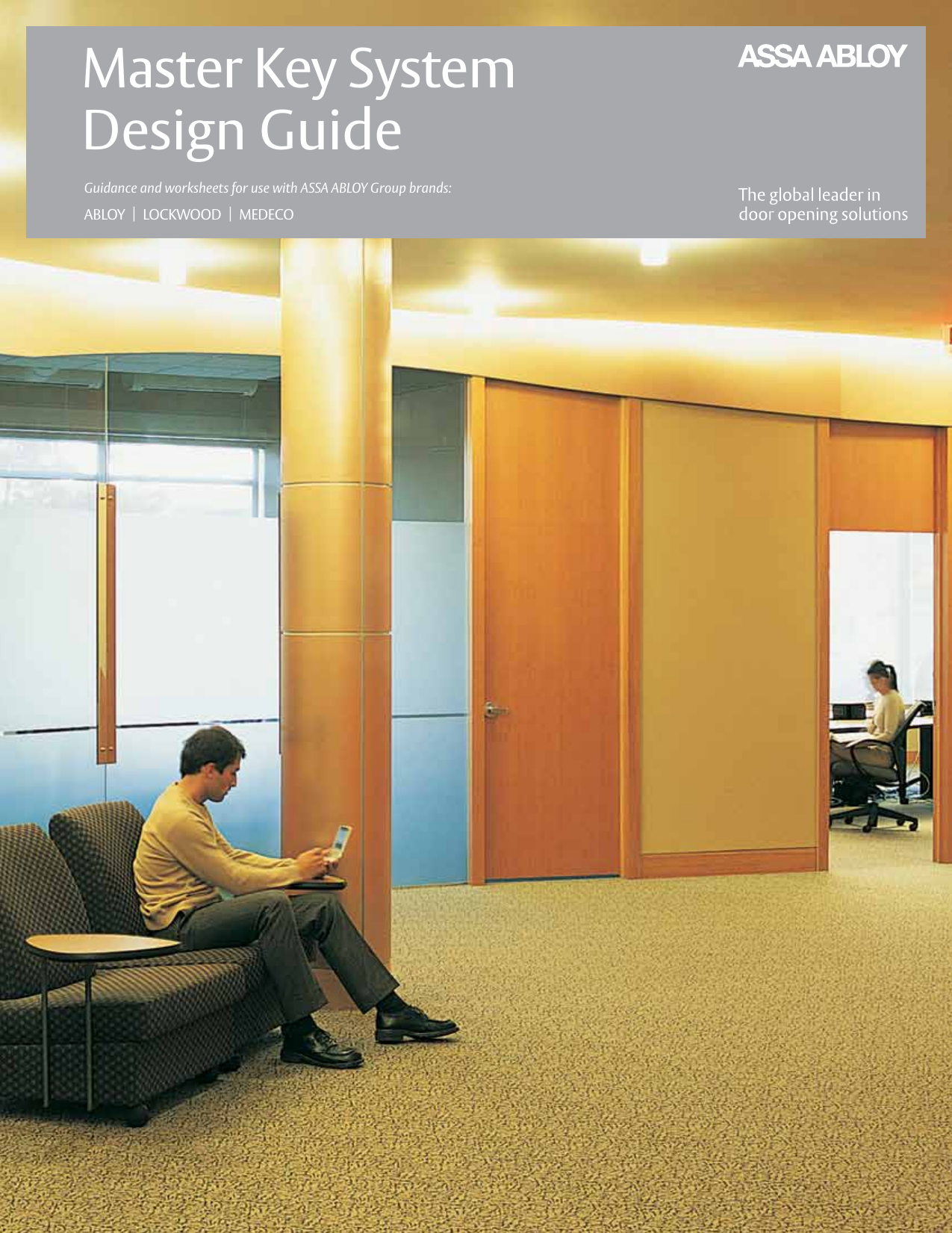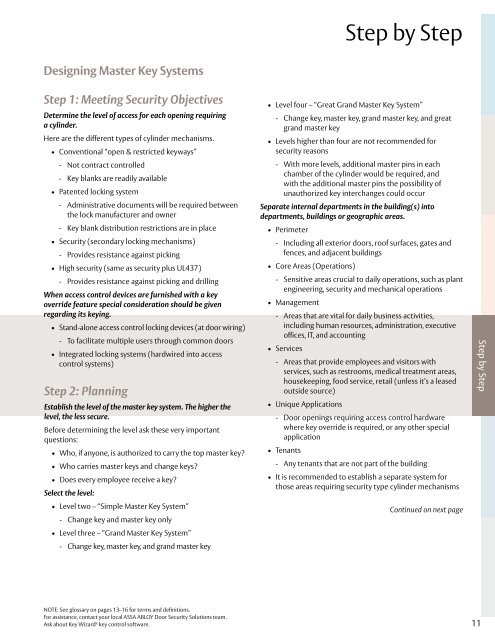The super of our apartment building is always going into everyone's apartment when something needs to be fixed. There must be a hundred apartments, but he only carries one key around with him. How does he get into all those apartments with the same key?
The last article (October 2004 Locksmith Ledger) demonstrated how to determine the power and characteristics of a random key in the master key system by decoding the key bittings. Generic Types were used to target how the key performed within the master key system and on a page, demonstrating the power of the key. (1) The alternate key to the key box will be placed in a sealed envelope. The key custodian (armorer) will put his signature and date across the sealed flap of the envelope and hand receipt it to the CO/1SG or KCO for storage. (2) The locked box containing the Alternate arms room keys will be hand receipted to the S-2 for storage.
Although locks come in all shapes and sizes, with many innovative design variations, most locks are based on fairly similar concepts. The most common lock design is the cylinder lock. In this design, the key turns a cylinder, or plug, which turns an attached cam. When the plug is turned one way, the cam pulls in on the bolt and the door can open. When the plug turns the other way, the cam releases the bolt and a spring snaps it into place so the door cannot open.
A master key operates a set of several locks. Usually, there is nothing special about the key itself, but rather the locks into which it will fit. How to have one master key for all your doors in your complex this will be done with minimal tools using several items found in your own home example a walgr.
Advertisement
Advertisement
The key your 'super' is using is called a master key. To understand how master keys work, you first have to have a basic idea of how locks and keys work.
Inside a cylinder lock, there is a sort of puzzle, which only the correct key can solve. The main variation in lock designs is the nature of this puzzle. One of the most common puzzles is the pin-and-tumbler design.
Check out the next page to learn more about this lock design.
Advertisement
The main components in the pin-and-tumbler design are a series of small pins of varying length. The pins are divided up into pairs. Each pair rests in a shaft running through the central cylinder plug and into the housing around the plug. Springs at the top of the shafts keep the pin pairs in position in the plug.
When no key is inserted, the bottom pin in each pair is completely inside the plug, while the upper pin is halfway in the plug and halfway in the housing. The position of the upper pins keeps the plug from turning -- the pins bind the plug to the housing.
Advertisement
Advertisement

When you insert a key, the series of notches in the key push the pin pairs up to different levels. The incorrect key will push the pins so that most of the top pins are still partly in the plug and partly in the housing. The correct key will push each pin pair up just enough so that the point where the two pins come together lines up perfectly with the space where the cylinder and the housing come together -- this point is called the shear line.
Some locks are designed to work with two different keys. The change key will open only that specific lock, while the master key will open that lock and several others in a group. In these locks, a few of the pin pairs are separated by a third pin. This third pin is called a master wafer or spacer.
When three pins are combined in a shaft, there are two ways to position the pins so they open the lock. The change key might raise the pins so that the shear line is just above the top of the master wafer, while the master key might raise the pins so the shear line is at the bottom of the master wafer. In both cases, there is a gap at the shear line and the key is able to turn.
In this lock design, the lowest pin is the same length in each lock in the group, but the master wafer varies in length. This lets the person with the master key access any lock in the group, while someone with a change key can open only his or her own lock.
Advertisement
Related HowStuffWorks Articles
Articles about masterkeying have appeared dozens of times in Locksmith Ledger. Masterkeying has been the topic of books by well-known people in our industry. Full one or two day classes on masterkeying are regularly presented at almost every locksmith convention. With this background, what could possibly be new or different about masterkeying that has not already been discussed?
What will be presented here is what might be called 'plug-in' masterkeying. It is designed to streamline the dull repetitive process of generating numbers and quickly move you into the profitable part of your job which is key cutting and rekeying.
First, a short primer on key bitting arrays. Yale set the general size for pin tumbler keys 150 years ago. Given this size, it was discovered that the Yale key size allows approximately 10 steps, or increments of depth from the highest possible cut on the key to the lowest possible cut. Lock companies may differ on what the dimension of each depth increment may be (usually between .0125' and .019') but regardless of the dimension being used, the amount of different possible increments for most popular lock companies is 10.
Most popular lock systems use five pin chambers for keying. Some commercial systems may use six or seven pin chambers, but this article will concentrate on a five chamber key system.
Variables such as parts wear and mass production can provide unplanned tolerances in a lock cylinder. With enough tolerance, key cuts such as 13131 and 14141 may unintentionally operate the same cylinder. This is called key interchange and must be avoided. In order to avoid interchanges, masterkey systems are designed to use a larger dimension of two increments between key cuts. Therefore in a masterkey system using key cuts such as 13131 and 15151, cuts of 14141 would not be used at all in order to prevent interchanges. .
Most popular keying systems use a depth numbering system of either 0-9 or 1-10. Since single increment steps should be avoided when masterkeying most lock brands, cut choices in a given chamber will be either 02468 or 13579. Note that the two choice groups are all even numbers or all odd numbers.
One of the key cuts in each chamber will be set aside for the master key cut. This leaves four choices of cut numbers per chamber for individual key combinations in the system which are called change key combinations. Due to four cut choices per chamber, this masterkeying system has become known as the quadrant system.
In order to use this plug-in masterkey system, you must know the cut numbering used by the lock system you are rekeying. As example, Schlage uses a numbering system of 0-9. '0' is the shallowest cut and '9' is the deepest cut. Sargent sectional keyways use a 1-10 numbering system. '1' is the shallowest cut and '0' (10) is the deepest cut.
Knowing the numbering system is important because not all cut combinations can be used due to maximum adjacent cut (MAC) problems. When a very deep cut is made next to a very shallow cut, the 'V' shaped cutter will remove so much material on each side of the deep cut that no key blank material is left for making an adjacent very shallow cut. Each lock company has their own MAC rule.

Master Keying Guide 2017
Before using the plug-in system you must develop the master key cuts. A good master key combination should contain one of the highest cuts in at least one space. This prevents someone from recutting another key in the system to produce a master key. The best master key cuts will have a combination of odd and even adjacent numbers. Master key cuts which use all even or all odd numbers will produce change keys with many repetitive cuts such as 44446 or 53333. These key combinations do not look secure, may allow the key to be removed in the wrong position and may be easier to pick open.
Bitting Charts
You are now ready to develop a bitting chart and use the plug-in masterkey system. An example of Schlage master key cuts may be: 01014. Pv sol premium 7.5 crack. The master key cut in chamber one is '0'. This leaves change key cut possibilities in the first chamber of 2468. Moving to the second chamber, the example masterkey cut '1'. This leaves change key cut possibilities of 3579. Bitting choices for the remaining chambers are chosen in the same fashion.
The resulting example key bitting array might be:
Masterkey 1: 0 1 0 1 4
Masterkey 2: 2 3 6 5 8
Schlage Master Keying Instructions
Masterkey 3: 6 9 4 9 0
Masterkey 4: 4 5 2 7 2
Masterkey 5: 8 7 8 3 6
Although this example bitting array shows the change key choices in a set order, any mix of the numbers could have been entered. As example, the first space numbers of 2648 could have been arranged differently such as 6284, 4682, etc.
Once you have developed a bitting array, the numbers can be 'plugged-in' to the chart. Numbers on the chart do not show actual cuts, but rather show the position of key cuts in your key bitting array. Therefore cuts for key A01 would be taken from position 2 in each space or 23658. Cuts for key A02 would be taken from position 2 except for space 5 which is position 3. Therefore A02 key cuts would be 23650, A03 cuts would be 23652 and A04 cuts would be 23656 .
If needed, HGM (horizontal master keys), VGM (vertical master keys), page master and four page master key cuts are chosen in the same way. In the example bitting array, the VGM 1-16 key is chosen from array positions 22211, or cuts of 23614. If a cylinder is set to the master key and a change key, vertical, horizontal and page master keys designed to operate the chosen change key will function without adding any additional master chips.
The complete plug-in master key system contains 16 pages with 64 codes per page, or a total of 1024 change key codes. The amount of usable combinations depends on the cut numbers chosen for your bitting array and the MAC number used by the lock manufacturer. Generally about 10 percent of the total change key and lower level master key combinations cannot be used no matter what numbers are used for your bitting list.
Page 1 of the plug-in master key system is included with this article. The remaining 15 pages can be downloaded from the Locksmith Ledger website. By choosing a new, original bitting array for each masterkeying job you do, the plug-in masterkey system charts can be used forever. Locks using single-step masterkey systems such as Kwikset can also be applied to these charts by choosing four single-step cut possibilities per chamber.